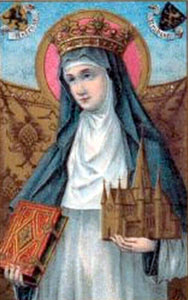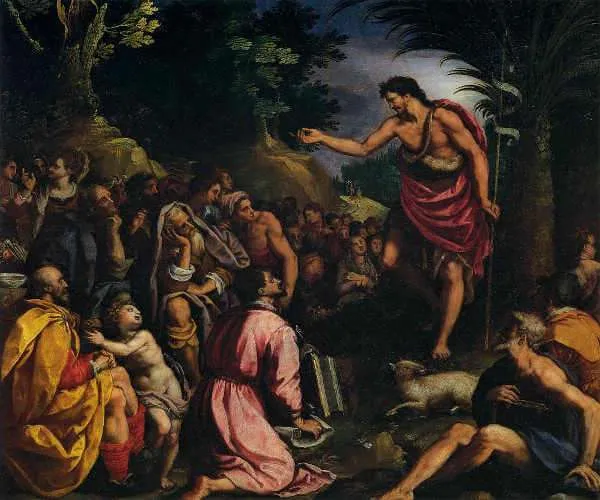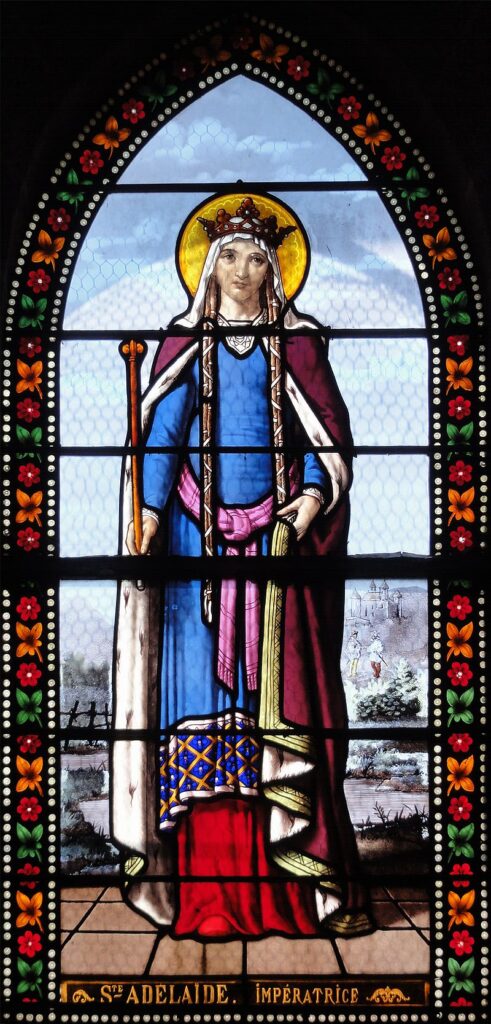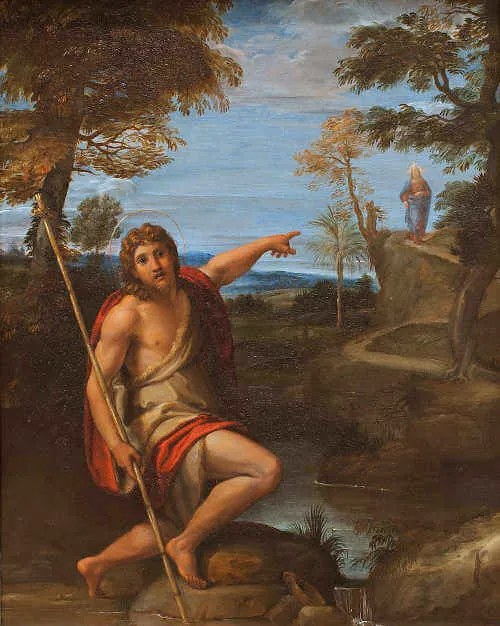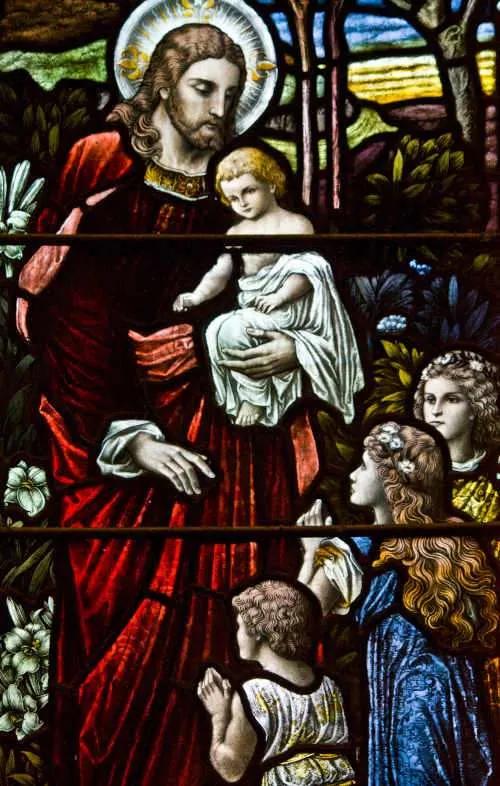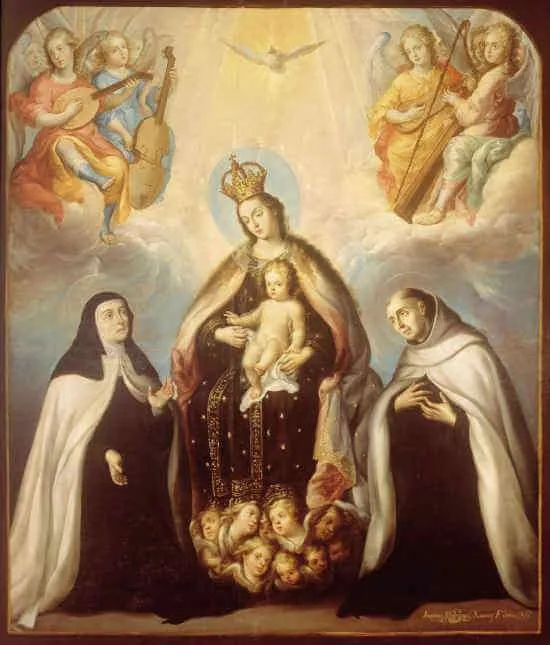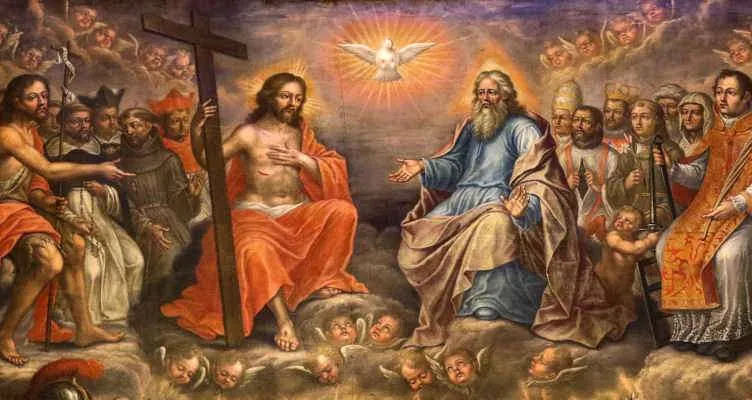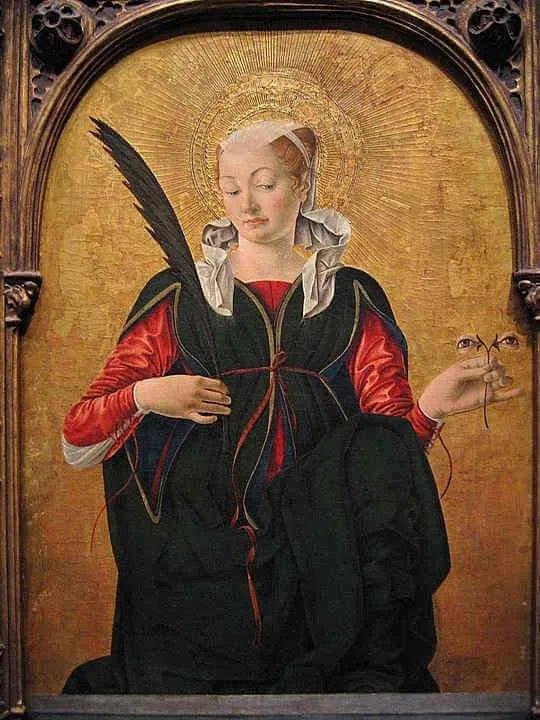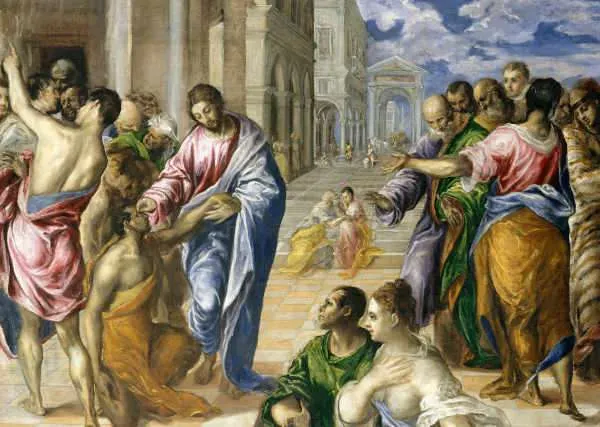Saint Begga of Andenne
Saint Begga of Andenne Read More »
Profile
Begga was born to the nobility, the daughter of Saint Pepin of Landen, mayor of the palace, and Saint Ida of Nivelles. She was the sister of Saint Gertrude of Nivelles.
Begga was married to Ansegilius, son of Saint Arnulf of Metz. Her son, Pepin of Herstal, was the founder of the Carolingian dynasty of rulers in France, in 635.
On the death of her husband in 691 in a hunting accident, Begga took the veil, founded seven churches, and built a convent at Andenne on the Meuse River (in modern Belgium) where she spent the rest of her days as abbess.
Died
693 at Andenne on the Meuse River in modern Belgium
Canonized
Pre-Congregation
Patronage
Andenne, Belgium
Source:
Saint Begga of Andenne
https://en.wikipedia.org/wiki/Begga#/media/File:Begga_de_landen.jpg
Saint Begga of Andenne Read More »
“I am the voice of one crying out in the desert, ‘make straight the way of the Lord,’” as Isaiah the prophet said.”
Reflection:
In the passage above, Saint John the Baptist quotes Isaiah 40:3: “A voice proclaims: In the wilderness prepare the way of the LORD! Make straight in the wasteland a highway for our God!” This was a prophecy of Isaiah who was speaking about the return of the Jewish exiles from Babylon back to Jerusalem.
Normally, people would travel along the well-watered routes from Mesopotamia to Israel. Those routes were safer than the desert and provided the necessary food and water for the journey. But Isaiah prophesied that the Jewish exiles would travel the shortest route—straight across the desert—and that God would provide for their needs during that journey. Such a journey required much trust in the providence of God.
John the Baptist, in quoting Isaiah, applies this prophecy to himself. He was called to cry out in the desert and point people directly to the Messiah. It was in the desert that they would discover their Savior.
First of all, John cries out in the “desert.” His message is for those who experience dryness, destitution, need and loss in life due to sin. His message of repentance is first for those who are without the spiritual nourishment God wants to bestow upon them through grace. The message of John is pointed to those who humbly see the difficult situation they are facing in life and acknowledge their need for the Living Water of the Savior of the World.
Second, this new “straight” way implies that many are not walking the direct path to Christ. Instead, they are taking unnecessary detours in life. John’s message is one that calls everyone to the straight and direct way of repenting of their sins so that they can come to faith in Christ Jesus.
Third, walking through the desert to find Christ requires trust in God’s providence. It takes courage to make such a journey. Trust in the ongoing providence of God, Who promises to meet all of our needs, is key. One would not walk straight through the desert if they did not trust their guide.
Advent is a time to reexamine the road you are on. Are you trying to find your own way to happiness? Are you trusting in your own abilities, your own intelligence and your own plan for the future? If so, then listen to the “voice of one crying out in the wilderness.” Listen to Saint John speak to you, calling you to the simplicity of the desert, to a greater detachment from all things, to an abandonment of all that is not of God, and to a more willing trust in the providence of God to lead you.
Reflect, today, upon this calling from the desert and listen to the message God is speaking to you, personally. Abandon all worldly concerns, repent of sin, trust in Him and go out to meet Him so that you can more quickly and more easily come to a deeper faith in our Lord during this Advent season.
Source: https://catholic-daily-reflections.com/2023/12/16/meeting-christ-in-the-desert/
Profile
Adelaide was born a princess, the daughter of King Rudolf II (Rupert II) of Upper Burgundy. She was promised at age two in an arranged marriage as part of a treaty between Rudolf and Hugh of Provence. She was married at age 16 to Lothair of Italy, who eventually became king of Italy.
Adelaide was widowed in 950 while still a teenager; Lothair was probably poisoned by his successor to the throne, Berengarius. As part of his attempt to solidify his grip on power, Berengarius ordered Adelaide to marry his son; she refused, and was imprisoned. She was freed soon after when the German king Otto the Great defeated Berengarius.
Adelaide married Otto in Pavia, Italy in 951. He was crowned Emperor in Rome, Italy in 952, and Adelaide reigned with him for 20 years. Widowed in 973, she was ill-treated by her step-son, Emperor Otto II and his wife Theophano, but eventually reconciled with her royal in-laws.
When Otto II died in 983, he was succeeded by his infant son, Otto III. Theophano acted as regent, and since she still did not like Adelaide, used her power to exile her from the royal court. Theophano died in 991, and Adelaide returned once again to the court to act as regent for the child emperor.
Adelaide used her position and power to help the poor, to evangelize, especially among the Slavs, and to build and restore monasteries and churches. When Otto III was old enough, Adelaide retired to the convent of Selta near Cologne, a house she had built. Though she never became a nun, she spent the rest of her days there in prayer.
Born
c. 931 in the kingdom of Burgundy, Holy Roman Empire (modern Burgundy, France)
Died
16 December 999 at the monastery of Selta (Seltz), Alsace of natural causes
Canonized
1097 by Pope Urban II
Patronage
Representation
Source/s:
Saint Adelaide of Burgundy
https://en.wikipedia.org/wiki/Adelaide_of_Italy#/media/File:Sainte-Ad%C3%A9la%C3%AFde_-_%C3%89glise_de_Toury,_vitraux_par_Lorin.jpg
Saint Adelaide of Burgundy Read More »
“I tell you that Elijah has already come, and they did not recognize him but did to him whatever they pleased. So also will the Son of Man suffer at their hands.” Then the disciples understood that he was speaking to them of John the Baptist.”
Reflection:
The last of the Old Testament Prophets was Malachi. He concluded his ministry about 400 years prior to the coming of Christ. Malachi prophesied that a “messenger” would come before the Messiah so as to prepare the way before Him. Malachi goes on further to say that “Elijah the Prophet” will come before the day of the Lord (See Malachi 3:1–24).
Many of the people at the time of Jesus did not understand this prophecy and were not even aware of it. Therefore, the scribes used this prophecy to confuse many of the people by claiming that since “Elijah” had not come, then clearly Jesus was not the promised Messiah.
Jesus clarified to the disciples that the “messenger,” who was to be the new Elijah, had already come in the person of John the Baptist. Thus, in clarifying this, Jesus also clarified that the scribes were not accurate in their attempt to interpret the Scriptures and were actively misleading the people on account of their errors.
One thing this tells us is that we must approach the word of God with humility. The pride of the scribes led them to believe that they had some sort of extraordinary wisdom that they did not. Thus, they acted as poor spiritual teachers of the people of God.
Humility before the Word of God is essential if we are to properly understand not only the Old Testament prophecies but also the very words of Jesus Himself. Without humility before the Word of God, we can all easily misinterpret the beautiful and holy words spoken by our Lord.
Everything in the Scriptures is profound, deep and true. And by this holy Word of God we come to meet God Himself. But if we allow pride to seep in, we may find ourselves imitating the scribes and misunderstanding God’s Word.
The result will be a skewed image of God which will become an impediment to our personal encounter with our loving Lord. But if we can always remain humble before all that God has revealed to us, then we will more easily be open to those deepest and most beautiful truths God wants to speak to our hearts.
Reflect, today, upon any way that you have found yourself confused by the Word of God. Try to humbly open your heart more fully to that which our Lord wants to speak to you. Listen with an open mind and heart and allow the pure gift of faith to become your guide so that you will be led to those deepest truths of our faith.
Source: https://catholic-daily-reflections.com/2023/12/15/approaching-the-word-of-god-2/
Profile
Mary is one of the nine children born to the industrialist Clement di Rosa and Countess Camilla Albani. Her father owned a large spinning mill, and Mary grew up in a happy and pious family. She was educated by Visitandine nuns.
Mary’s mother died when she was seventeen, and she left school to help manage her father‘s estate. Her heart set on a religious life, she turned down many suitors. She worked with young girls in her community, those who worked in her father‘s mills, and the sick in local hospital. She also work tirelessly during the cholera epidemic of 1836.
Mary founded a home dedicated to the spiritual needs of young girls, and a school for deaf children. In 1840, she became the superior of the Handmaids of Charity, nuns who cared for the sick, and she took the name Mary Crucifixa. The community received their bishop‘s approval in 1843 and papal approval in 1850. Mary led them until her death.
Born
6 November 1813 in Brescia, Italy as Paula Frances Mary di Rosa
Died
15 December 1855 in Brescia, Italy of natural causes
Venerated
10 July 1932 by Pope Pius XI (decree of heroic virtues)
Beatified
26 May 1940 by Pope Pius XII
Canonized
12 June 1954 by Pope Pius XII
Source: https://catholicsaints.info/saint-mary-di-rosa/
Saint Mary di Rosa Read More »
“Jesus said to the crowds: “To what shall I compare this generation? It is like children who sit in marketplaces and call to one another, ‘We played the flute for you, but you did not dance, we sang a dirge but you did not mourn.’”
Reflection:
What does Jesus mean when He says “We played the flute for you…” and “we sang a dirge…?” The Church Fathers clearly identify this “flute” and “dirge” as the word of God that has been preached by the prophets of old. So many came before Jesus to prepare the way, but so many failed to listen. John the Baptist was the final and greatest prophet, and he called people to repentance, but few listened. Thus, Jesus points out this sad truth.
In our day and age, we have so much more than the prophets of the Old Testament. We have the incredible witness of the saints, the infallible teaching of the Church, the gift of the Sacraments and the life and teaching of the Son of God Himself as recorded in the New Testament. Yet, sadly, so many refuse to listen. So many fail to “dance” and “mourn” in response to the Gospel.
We must “dance” in the sense that the gift of Christ Jesus, by His life, death and resurrection should be the cause of our wholehearted rejoicing and eternal adoration. Those who truly know and love the Son of God are filled with joy! Furthermore, we must “mourn” on account of the countless sins in our own lives and in the lives of those all around us. Sin is real and prevalent, and a holy sorrow is the only appropriate response. Salvation is real. Hell is real. And both of these truths demand a total response from us.
In your own life, how fully have you allowed the Gospel to affect you? How attentive are you to the voice of God as it has been spoken through the lives of the saints and through our Church? Are you tuned in to the voice of God as He speaks to you in the depths of your conscience in prayer? Are you listening? Responding? Following? And giving your whole life in the service of Christ and His mission?
Reflect, today, upon the clear, unmistakable, transforming and life-giving words and presence of the Savior of the world. Reflect upon how attentive you have been in life to all that He has clearly spoken and to His very presence. If you do not find yourself “dancing” for God’s glory and “mourning” over the evident sins of your life and within our world, then recommit yourself to a radical following of Christ. In the end, the Truth that God has spoken throughout the ages and His holy and divine presence are all that matter.
Source: https://catholic-daily-reflections.com/2023/12/14/dancing-and-mourning-3/
In 1545, when Juan was only three years old, his father died, leaving Catalina to raise and provide for their boys, a difficult responsibility for a widow at that time. She sought assistance from Gonzalo’s family but was rejected. Therefore, she and her boys lived in destitution. Two years after Gonzalo’s death, Luis died of malnutrition. Eventually, Catalina took Francisco and Juan and moved to Medina del Campo, a larger city, and resumed her work as a weaver.
In Medina, Juan was able to attend a boarding school for poor children. He received a basic education, housing, and food. Juan proved to be an excellent student and, in 1559, was invited to study at the nearby newly founded Jesuit school at the age of seventeen. With the Jesuits, Juan studied the humanities, grammar, rhetoric, Latin, and Greek. Four years later, in 1563, he entered the Carmelite Order, taking the name John of Saint Matthias.
John made his profession as a Carmelite in 1564 and subsequently received special permission from his superiors to follow the ancient Carmelite rule to the letter, rather than embrace the various changes to the rule that occurred over the years. After his professions, he was sent to study theology and philosophy at the prestigious university in Salamanca. There he excelled in his studies and was known for his intelligence and insights.
At the end of his studies, John had second thoughts about his vocation as a Carmelite, preferring instead to live a more contemplative life. As a result, he decided that he would enter the Carthusians once he was ordained. John was ordained a priest in 1567.
Father John returned to Medina to offer his first Mass. However, his intention to join the Carthusians all changed after meeting the Carmelite nun Teresa of Ávila. Mother Teresa was a reformer of the Carmelite Order and was in Medina to found a new convent. While there, she heard of the newly ordained priest, Father John, and attended his first Mass. Later, she spoke to him about her ideas on reforming the Carmelites in hopes that he would become her first friar in the reform. Father John was intrigued and accepted her invitation to remain a Carmelite and assist her with the new reforms, reviving the ancient rule.
After returning with Mother Teresa to Valladolid, he participated in a period of formation under her guidance and founded the first house for friars, along with two other Carmelite brothers. This first house began formally on November 28, 1568. Father John gave up his old name and took on the new name of Father John of the Cross. As more friars joined them, Father John, now the subprior and novice master, moved to a larger house in nearby Alcalá where he also became the rector of the university.
In May of 1572, Mother Teresa asked him to move to Ávila to become the spiritual director for the sisters at the Monastery of the Incarnation. He remained there for five years, working closely with the sisters and growing deep in his own spiritual life. He was especially blessed to act as spiritual director to Mother Teresa who, in many ways, acted as a spiritual guide to him.
Shortly after his arrival in 1572, Mother Teresa entered into the spiritual transformation of the Divine Union while Father John acted as her spiritual director. At times, their conversations led both of them into ecstasy as the Holy Spirit worked powerfully in their lives and through their spiritual friendship.
Sadly, politics had its place in the Church at that time, and there were some who did not like the idea of reforming the Carmelite order. In January of 1576, Father John was arrested for the first time by the more contemporary and well-established Carmelites of the Observance. They wanted to end the reforms of Father John and Mother Teresa and their Discalced Carmelites (meaning those who wore sandals rather than shoes).
His arrest was quickly ended by the intervention of the papal nuncio, Nicolás Ormaneto, who was favorable toward the reforms of the Discalced Carmelites. However, the following year, in June of 1577, the nuncio died. A new nuncio was appointed who was not in favor of the reforms. In December of that year, Father John was once again arrested by the Carmelites of the Observance and put in prison in their monastery in Toledo, where he remained for nine months.
After Father John’s arrest, the Provincial ordered him to “repent” of his reforms and to return to the monastery in Medina. Father John refused to do so, arguing that he was not bound by the Provincial’s demands, since he had received permission for his work on the reform from the nuncio Ormaneo while he was alive. As a result, Father John was judged as being rebellious and willfully disobedient to their authority and was imprisoned in a six-by-ten-foot dungeon cell.
During the nine months of his imprisonment, Father John was regularly abused by the friars in attempts to get him to “repent.” He was given no change of clothing, very little food, endured a severe case of lice, and had only his breviary to read. He endured the severe cold of the winter and the heat of the summer in the small dark cell that had only one small window high up on the wall.
However, it was during this time of abuse that some of the greatest spiritual treasures to fill our Church were born. Father John, in the darkness of this prison, composed numerous poems, including Dark Night of the Soul and portions of the Spiritual Canticle. God did not allow this abuse to go fruitless. Father John grew deep in the spiritual life and entered into interior freedom through his prayer and surrender to God.
In August of 1578, it is said that God miraculously enabled Father John to escape at night “in the darkness,” as his poem relates, and find refuge with Mother Teresa’s sisters in Toledo. Eventually, he escaped to Santa Cruz, where he was cared for secretly and nursed back to full health.
Over the coming years, his prison experience, the poems he composed, and his life of deep prayer and study prepared him to write four of the greatest works on mystical theology the Church has ever known: Ascent to Mount Carmel, Dark Night of the Soul, Living Flame of Love, and Spiritual Canticles. Each book was a commentary on the mystical poems he had composed. The poems themselves are considered to be among the most beautiful poems written in the Spanish language.
During the year after Father John escaped imprisonment, the Discalced Carmelites did all they could to regularize their situation within the larger Carmelite order and within the Church. Though the new nuncio tried to stop them, the king intervened. In April of 1579, a new provincial was appointed to oversee the Discalced Carmelites and to assist them with their reforms.
In 1580, the Holy See allowed the Discalced Carmelites to enjoy independence from the Carmelites of the Observance, and Father John was appointed as prior of one of the new monasteries. Mother Teresa died in 1582. In 1585, the Discalced Carmelites were given even greater independence from the Carmelites of the Observance when they were established as an independent province. Father John was elected Vicar Provincial.
The charisms of this reform in which Father John and Mother Teresa were so instrumental included the following: 1) a strong Marian devotion, 2) a daily plan carefully set forth to maintain a life of continual prayer, and 3) a strict rule of enclosure focused on the asceticism of solitude, manual labor, perpetual abstinence, fasting, and fraternal charity. Many were attracted to this new strict Carmelite life. Therefore, monasteries of both nuns and friars continued to be founded.
Father John continued to found monasteries and oversee the reform until September of 1591, when he developed gangrene on his leg. He went to a monastery in Ubeda to receive care for his illness. Instead, the superior treated him coldly, arguing that Father John was a burden to the monastery.
On December 13, just hours before his death, Father John called the prior to his cell and humbly begged his forgiveness for being a burden. This act of humility completely transformed the prior who was overwhelmed by Father John’s sanctity. At midnight, the saintly friar went home to Heaven to his Beloved to sing Matins with the angels, thus completing his mystical journey to divine union.
Saint John of the Cross endured many trials throughout his life, but God used those trials as a foundation for the spiritual formation he would provide to the Church through his masterful mystical theology. It could be argued that no one has captured the depths of the spiritual life, leading us to Divine Union and Mystical Marriage, better than Saint John of the Cross. He did not shy away from describing, in great detail, the interior purifications a soul must endure on that journey to complete freedom.
As we honor that great saint and mystical doctor of the Church, ponder the profound spiritual truth—that complete union with God is an ongoing process that requires total surrender, interior purgations of the senses and spirit, mortification, and mystical annihilation. Though these concepts are deep and utterly otherworldly, they are beautiful truths that the Church continues to uphold. Allow Saint John to inspire you to go deeper in your faith journey so that your divine union will evolve and blossom into the glorious life God desires for you.
Source: https://mycatholic.life/saints/saints-of-the-liturgical-year/14-december-saint-john-of-the-cross-priest-and-doctor–memorial/
Saint John of the Cross, Priest and Doctor Read More »
“From the days of John the Baptist until now, the Kingdom of heaven suffers violence, and the violent are taking it by force.”
Reflection:
Are you among those who are “violent” and are taking the Kingdom of Heaven “by force?” Hopefully you are!
From time to time, Jesus’ words are difficult to understand. This passage above presents us with one of those situations. Of this passage, Saint Josemaría Escrivá states that the “violent” are Christians who have “fortitude” and “boldness” when the environment they find themselves in is hostile to the faith (See Christ is Passing By, 82).
Saint Clement of Alexandria says that the Kingdom of Heaven belongs “to those who fight against themselves” (Quis dives salvetur, 21). In other words, the “violent” who are taking the Kingdom of Heaven are those who vigorously fight against the enemies of their soul so as to obtain the Kingdom of Heaven.
What are the enemies of the soul? Traditionally, we speak of the world, the flesh and the devil. These three enemies have caused much violence within the souls of Christians who are striving to live within God’s Kingdom. So how do we fight for the Kingdom? By force! Some translations say that the “attackers” are taking the Kingdom by force.
This means that the Christian life cannot be one that is purely passive. We cannot simply smile our way into Heaven. The enemies of our soul are real, and they are aggressive. Therefore, we must also become aggressive in the sense that we must directly take on these enemies with the fortitude and boldness of Christ.
How do we do this? We take on the enemy of the flesh by fasting and self-denial. We take on the world by remaining grounded in the Truth of Christ, the Truth of the Gospel, refusing to conform to the “wisdom” of the age. And we take on the devil by becoming aware of his malicious plans to deceive us, confuse us and mislead us in all things so as to rebuke him and reject his actions in our life.
Reflect, today, upon your call to grow in fortitude and boldness so as to combat those enemies that attack within. Fear is useless in this battle. Confidence in the power and mercy of our Lord Jesus Christ is the only weapon we need. Rely upon Him and do not give in to the many ways that these enemies seek to rob you of the peace of Christ.
Source: https://catholic-daily-reflections.com/2023/12/13/attacking-the-enemies-of-the-soul-2/
Lucy was born in Syracuse, Sicily, around the year 283 to Christian parents. When she was five, her father died, leaving her mother, Eutychia, to raise her alone. Eutychia suffered from hemorrhages and feared for Lucy’s future, so she arranged a promise of marriage for her daughter to a nobleman from a pagan family.
A half century earlier, the holy virgin Saint Agatha had been martyred forty miles north of Syracuse in the city of Cantania. Saint Agatha was revered as the glory of Cantania. Her tomb became a popular place of pilgrimage and site of many miracles. Hopeful of a cure of her mother’s hemorrhages, Lucy convinced her mother to make a pilgrimage to Saint Agatha’s tomb. Eutychia agreed.
While at the tomb, the two fervently prayed for a long time. As they did, Lucy had a dream-like vision in which Saint Agatha appeared to her, informing her that her mother would be cured because of Lucy’s faith, and that Lucy would become the glory of Syracuse, just as Agatha was the glory of Cantania. When Lucy awoke from her vision, she cried out, “O, mother, mother, you are healed!”
From that moment on, Lucy continued to sense Saint Agatha speaking to her about her calling to be a Bride of Christ and to die as a martyr. She informed her mother of her desire to remain a virgin and begged her to offer their wealth to the poor. Her mother hesitated, suggesting it would be better for Lucy to do so once Eutychia had died, but Lucy urged her to do so right away because it would be a source of much greater merit. Lucy’s faith won the day. She continued to postpone her marriage and spent the next few years joyfully distributing her money and jewels to the poor.
In the year 303, Roman Emperor Diocletian issued an edict outlawing Christianity in the Roman Empire. Christian Churches and sacred texts, such as Scripture and liturgical books, were to be destroyed. Christians were forbidden to gather for worship. Civil servants and nobility were stripped of their ranks and belongings. Christians who were discovered were forced to offer sacrifice to the Roman gods and the emperor; those who refused were tortured and even killed.
Though this was clearly a grave evil to befall those who professed their faith in Christ, it also resulted in a strengthening of faith for many. Secret worship regularly took place at the risk of the worshippers’ lives. Honored martyrs inspired the faithful to imitate the martyrs’ steadfast faith.
Around the year 304, when Lucy was around the age of twenty-one, her suitor became aware of the large sums of money that she had distributed to the poor. He was also aware that Lucy had done so on account of her Christian faith and realized that she was not going to become his bride. Enraged, he reported Lucy to Paschasius, the Governor of Syracuse, denouncing her as a Christian.
When Governor Paschasius of Syracuse learned of Lucy’s Christian faith and her charity to the poor, he had her arrested and interrogated. He attempted to force her to apostatize by offering sacrifice to the Roman gods, but she refused. A later Roman martyrology put these words into Lucy’s mouth:
“I know but one sacrifice pure and full of honor, which I can offer. This is to visit orphans and widows in their tribulation, and to keep oneself unspotted from the world. For three years, I have daily offered this sacrifice to my God and Father; and now I long for the happiness of offering myself to Him as a living victim. His holy will be done!”
Lucy then accused the governor of demon worship and prophesied his condemnation before God. The governor was outraged and ordered her to be defiled in a brothel. When the guards tried to move her, she was heavier than a boulder. They even tried to move her with a rope tied to the yoke of oxen, but she didn’t budge. The guards then surrounded her with wood to burn her, but the flames did not harm her. Finally, the governor ordered a soldier to thrust his sword into her neck, and God permitted her martyrdom to be completed. One martyrology attributes these prophetic words to her as she was dying:
“I announce to you a great joy. Diocletian descends from his throne, Maximian dies, the Church breathes again: peace extends its protecting wing over the martyred Saints. O Syracuse, O place of my birth, as Catania finds its safety and glory beneath the guardianship of my sister Agatha, so shalt thou be shielded by me, if thou art willing to embrace that Faith, for the truth of which I shed my blood.”
Saint Lucy is often depicted in sacred art holding her eyes because much later legends state that either the guards gouged her eyes out as torture, or that she gouged her own eyes out so that her suitor would no longer be tempted by their beauty.
Veneration to Saint Lucy quickly spread, and her prophetic dream-vision came true—she became the glory and protector of Syracuse and the source of many miracles. By the end of the sixth century, she was so revered throughout the Roman Empire that Pope Saint Gregory the Great inserted her name into the Roman Canon (Eucharistic Prayer I)—“…graciously grant some share and fellowship with your holy Apostles and Martyrs: with John the Baptist, Stephen, Matthias, Barnabas, Ignatius, Alexander, Marcellinus, Peter, Felicity, Perpetua, Agatha, Lucy, Agnes, Cecilia, Anastasia and all your Saints…”
The fact that a young virgin martyr would become so revered and honored for many centuries after her birth is a testimony to the power of God. Saint Lucy not only imitated her Lord, but in her humility, she reflected the glory of the Mother of God who, in her song of praise, proclaimed, “For he has looked upon his handmaid’s lowliness; behold, from now on will all ages call me blessed. The Mighty One has done great things for me, and holy is his name…” (Luke 1:49–49).
As we honor this saint who was crowned with virginity and martyrdom, ponder the courage and resolve she had to choose death over a life of nobility. She fell in love with her divine Spouse, He entered into union with her, and she turned her eyes firmly upon His holy will. Seek to imitate Saint Lucy’s courage and resolve, choosing Christ and Him alone, renouncing all that is contrary to His holy will.
Source: https://mycatholic.life/saints/saints-of-the-liturgical-year/13-december-saint-lucy-of-syracuse-virgin-and-martyr–memorial
Saint Lucy of Syracuse, Virgin and Martyr Read More »
“Come to me, all you who labor and are burdened, and I will give you rest.”
Reflection:
One of the most delightful and healthy activities in life is sleep. This is especially the case when one is able to enter into a deep and refreshing sleep. Upon awakening, the person who has slept deeply feels refreshed and ready for a new day. Of course, the opposite is also true. When sleep is difficult and restless, the person can suffer numerous ill effects, especially when a lack of healthy sleep becomes the norm.
The same is true in our spiritual lives. For many people, “spiritual rest” is something foreign to them. They may say a few prayers each week, attend Mass, or even make a holy hour. But unless each one of us enters into a form of prayer that is deep and transforming, we will not be able to experience the interior spiritual rest we need.
Jesus’ invitation in today’s Gospel to “Come to me…” is an invitation to become transformed, interiorly, as we allow Him to relieve us of the burdens of our daily lives. Each day we often face spiritual hardships and challenges, such as temptations, confusions, disappointments, angers and the like.
We are often daily bombarded with the lies of the evil one, the hostility of a growing secularized culture and an assault on our senses through the numerous forms of media we daily digest. These and many other things we encounter each and every day will have the effect of wearing us down interiorly on a spiritual level.
As a result, we need the spiritual refreshment that comes only from our Lord. We need the spiritual “sleep” that results from deep and revitalizing prayer. And that form of prayer is only possible if we heed Christ’s invitation to come to Him with every fiber of our being, surrendering all that we are and all that we encounter each and every day.
Reflect, today, upon whether you feel weary at times. Ponder, especially, any mental or emotional weariness. Oftentimes these forms of weariness are actually spiritual in nature and need a spiritual remedy. Seek the remedy our Lord offers you by accepting His invitation to come to Him, deeply in prayer, and rest in His presence. Doing so will help to lift the heavy burdens with which you struggle.
Source: https://catholic-daily-reflections.com/2023/12/12/laying-down-your-burdens-6/
Add San Jose Filipino Ministry as a new recipient, Send your donation using"[email protected]"
Payable to - San Jose Filipino Ministry
Address - 1235 S Magnolia Ave Anaheim, CA 92804-5115
1235 S.Magnolia Ave. Anaheim, CA 92804-5115
1235 S.Magnolia Ave. Anaheim, CA 92804-5115
Add San Jose Filipino Ministry as a new recipient, Send your donation using"[email protected]"
Payable to - San Jose Filipino Ministry
Address - 1235 S Magnolia Ave
Anaheim, CA 92804-5115
San Jose Filipino Ministry. All rights reserved. 2021 © Powered by Phoenix Virtual Solutions
Sponsored by EverClear Hospice and Palliative Care
